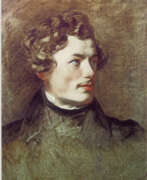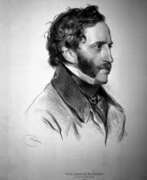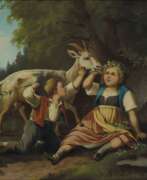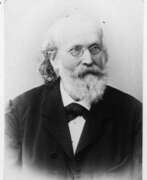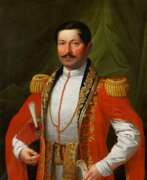Graphic artists Biedermeier
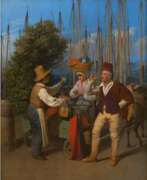

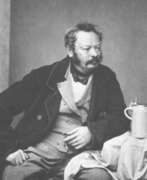

Heinrich Bürkel was a German artist of the mid-nineteenth century. He is known as a painter and graphic artist, representative of the Biedermeier style.
Heinrich Bürkel specialized in genre and landscape paintings, especially winter landscapes. He often used Staffage and depicted animals. His work showed the influence of the old Dutch and Italian masters. Bürkel enjoyed great popularity, his paintings were actively acquired for private collections, including in America. The master painted about 1000 paintings and created about 6000 drawings.
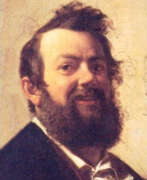

Johann Peter Hasenclever was a German painter of the first half of the 19th century. He is known as a painter, a representative of the Düsseldorf school of art, who is considered one of the founders of German genre painting.
Hasenclever began his work by interpreting biblical, mythological and romantic subjects, but eventually found his calling in humorous scenes from bourgeois life, especially Pyrenean towns and cities. Among his famous works are "The Amusing Examination," "The Reading Room," and "The Trial of Wine," distributed in engravings and lithographs.
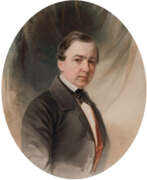

Woldemar Hau (Russian: Владимир Иванович Гау) was a Baltic German portrait painter, renowned for his contributions to the Biedermeier style, a period marked by a sense of realism and simplicity in art. Born in 1816 in Tallinn, then part of the Russian Empire, he was trained under the guidance of his father, Johannes Hau, and the distinguished artist Karl von Kügelgen. Hau's remarkable talent became evident early on when, at just sixteen, he was recommended to paint for the Russian Imperial Court, leading to his appointment as a Court Painter.
During his illustrious career, Hau captured the visages of the Russian nobility, including Tsar Nicholas I and Tsarina Alexandra Fyodorovna, alongside other key figures of his time. His works, often characterized by their intricate detail and vibrant realism, include over 200 miniature portraits of the Izmaylovsky Regiment veterans. His most celebrated works are preserved in prestigious collections and reflect his mastery in both watercolours and miniatures on ivory.
For those interested in exploring the legacy of Woldemar Hau, his paintings are a fascinating window into the cultural and historical nuances of 19th-century aristocratic Russia. To stay updated on exhibitions and auctions featuring Hau's work, I encourage you to sign up for updates. This subscription will keep you informed about new sales and auction events specifically related to Woldemar Hau.
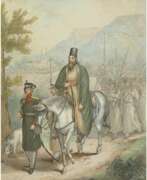

Georg Emanuel Opiz was a German painter of the first half of the 19th century. He is known as a painter, graphic artist, printmaker and author of historical novels, publishing under the pseudonym Bohemius.
Opiz began his career with portraits, but from 1807 moved on to genre subjects. He became famous for his watercolors and gouaches depicting daily life in Paris during the Napoleonic I era. His series of lithographs "Cossacks in Paris", executed from life in 1814, became very famous. In 1819 he published a series of 24 color prints "Scenes of Characters from Life in Paris". In the 1820s, Opiz created a series of watercolors, presumably inspired by trips to Russia and the Ottoman Empire.


Lorenzo Quaglio was an Italian-born German painter of the first half of the 19th century. He is known as a painter, landscape painter, genre painter and lithographer of the German Biedermeier period, a member of the Quaglio dynasty of artists, brother of the famous architect-artist Domenico Quaglio.
Lorenzo Quaglio worked early in his career as a decorator for the court of the Bavarian Electorate and the national theater in Munich. He traveled frequently in the Bavarian and Tyrolean Alps, which inspired him to create. His works predominantly depicted scenes from the peasantry of Upper Bavaria. He also executed on stone copies of paintings from the Dresden Gallery. In 1812, he created his first lithograph with nature scenes, and from 1820 he studied Bavarian folk costume. Later he worked on the decoration of the Swan Knight Hall in Hohenschwangau Castle.
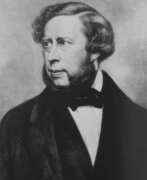

Julius Schoppe was a German painter of the mid-nineteenth century. He is known as a painter and graphic artist, famous for his portraits during the Biedermeier era.
Julius Schoppe studied Italian art in Rome and copied works by Raphael, Titian and Correggio. His copies of Raphael's paintings were included in the collection of the King of Prussia and were exhibited in Sans Souci. The master was also the author of landscapes, historical and genre paintings, as well as an original series of "living paintings" that were admired for their grace and painterly authenticity. He was a professor at the Berlin Academy of Fine Arts.
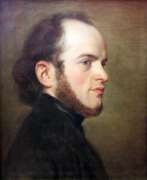

Adolph Friedrich Erdmann von Menzel was a German Realist artist noted for drawings, etchings, and paintings. Along with Caspar David Friedrich, he is considered one of the two most prominent German painters of the 19th century, and was the most successful artist of his era in Germany. First known as Adolph Menzel, he was knighted in 1898 and changed his name to Adolph von Menzel.
His popularity in his native country, owing especially to his history paintings, was such that few of his major paintings left Germany, as many were quickly acquired by museums in Berlin. Menzel's graphic work (and especially his drawings) were more widely disseminated; these, along with informal paintings not initially intended for display, have largely accounted for his posthumous reputation.
